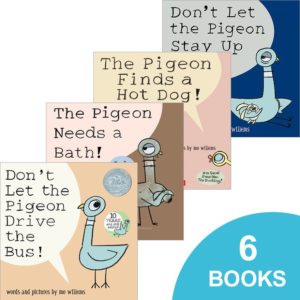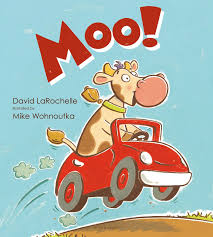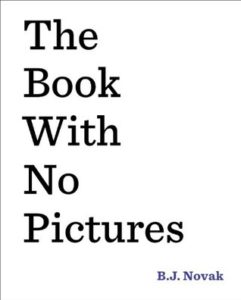Early Reading Skills
Every day students have to recognize their name and put it in the pocket on the wall to say they are “here”. We also place their names around the table at snack time for more name recognition. I praise them for finding their names, and say they are “Good Readers”, because in fact, they are!
 When I read stories to them, I describe HOW the words are written affects how I read it to them. This has been mentioned a lot when reading Mo Willems’ Pigeon stories. Pigeon tends to lose control and yell at least once in his books. We talk about how Mo wrote the words bigger and we look at the pictures and see how Pigeon’s feathers are flying off and his wings are flapping wildly, etc. You can tell he is upset. Then when the dog has a tiny “woof” in the corner, we know he is saying it quietly.
When I read stories to them, I describe HOW the words are written affects how I read it to them. This has been mentioned a lot when reading Mo Willems’ Pigeon stories. Pigeon tends to lose control and yell at least once in his books. We talk about how Mo wrote the words bigger and we look at the pictures and see how Pigeon’s feathers are flying off and his wings are flapping wildly, etc. You can tell he is upset. Then when the dog has a tiny “woof” in the corner, we know he is saying it quietly.
 Students “read” it that way, too, when we have reading time after snack. One book everyone thoroughly enjoys is Moo! by David LaRochelle. There are only two words in the whole book is “moo”, but we say it differently by how it is written. When the cow is driving up and down the hill, we make our voices go up and down, too. When she is sad we use a quiet sad voice. This is a great book for this age group since they truly can read it. There is one other word in the book, when the cow blames the sheep and says “Baa!”
Students “read” it that way, too, when we have reading time after snack. One book everyone thoroughly enjoys is Moo! by David LaRochelle. There are only two words in the whole book is “moo”, but we say it differently by how it is written. When the cow is driving up and down the hill, we make our voices go up and down, too. When she is sad we use a quiet sad voice. This is a great book for this age group since they truly can read it. There is one other word in the book, when the cow blames the sheep and says “Baa!”
 The Book With No Pictures by B. J. Novak, is another funny story the children enjoy. There are no pictures, it is only words, but it talks about how grown ups have to read the words on the page, no matter how silly they are. I do one edit when reading it aloud. I change the name of the hippo from Boo Boo Butt to Boo Boo Bottom. It is a great read aloud, since you are forced to use some silly voices because of what is written on the page.
The Book With No Pictures by B. J. Novak, is another funny story the children enjoy. There are no pictures, it is only words, but it talks about how grown ups have to read the words on the page, no matter how silly they are. I do one edit when reading it aloud. I change the name of the hippo from Boo Boo Butt to Boo Boo Bottom. It is a great read aloud, since you are forced to use some silly voices because of what is written on the page.
Mo Willems’ books are available on Scholastic book orders, but Moo! and The Book With No Pictures would have to be purchased from a bookstore.
Early Math Skills
Preschool math is a part of our play. It includes sorting, finding patterns, and much more beyond just counting. Recently, we have been working at number recognition and building towers to match the number.
Playing board games at home helps build these skills, too. Many games involve counting moves around the board, recognizing numbers on a spinner or dice, etc. Games also help with patience, when waiting turns. I can tell many children who play games with dice because they have immediate number recognition and do not have to count the dots.
Mrs. Risnes
